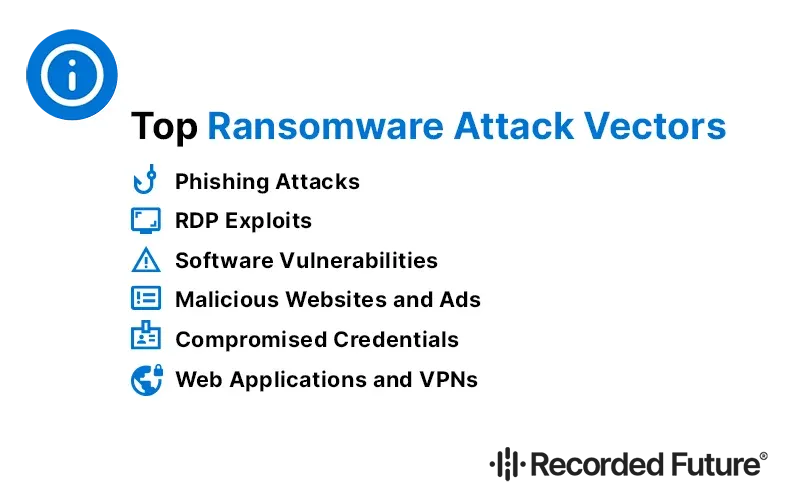Top 6 Ransomware Attack Vectors Targeting Enterprises and How to Defend Against Them
Ransomware attacks are increasingly sophisticated, with the 2024 Verizon Data Breach Investigations Report showing a 180% increase in exploitation of vulnerabilities, particularly zero-day threats. Phishing remains the top vector, while compromised credentials and software vulnerabilities also pose major risks. Understanding these threats is key to preventing them.
This article explores the key attack vectors, including phishing, RDP exploits, social engineering, and web applications, and provides strategies for defending against them.
Quick Facts
- Ransomware attacks have increased by 435% since 2020 (World Economic Forum) with phishing, RDP exploits and software vulnerabilities as the top vectors.
- Implementing email security protocols, cyber awareness training and keeping software up to date are key to preventing ransomware attacks.
- Advanced defense mechanisms like Endpoint Detection and Response, network segmentation, and Identity and Access Management are critical in responding to and containing ransomware threats.
%20ebook%20-%20Landing%20page.webp?width=376&height=600&name=2024_0627-%20transparent%20Ransomware-%20Understand.%20Prevent.%20Recover%20(Third%20Edition)%20ebook%20-%20Landing%20page.webp)
Ransomware: Understand. Prevent. Recover.
Ransomware Attack Vectors
A ransomware attack vector is the way cybercriminals get into your organization and deliver their malicious payload. In the world of cybersecurity, an attack vector is any method or pathway used to exploit vulnerabilities and gain unauthorized access to systems. Ransomware is a type of malware that locks down the victim’s system, makes files inaccessible and demands payment to release them. They have gotten more sophisticated and widespread so it’s essential to understand and stop them.
Knowing ransomware attack vectors is not just about knowing the methods used by attackers but also understanding the impact on your business. Digital transformation and remote work have created new vulnerabilities for organizations, accelerating the number of ransomware attacks. .
Ransomware is a major security threat to businesses today, from big companies to the public sector. Knowing how these attacks work can help you avoid security disasters. Knowing this can reduce your chances of being a victim.
Ransomware Attack Vectors
Ransomware has become one of the most prevalent and destructive forms of cyber threats, targeting organizations of all sizes. Understanding how these attacks are delivered is crucial for bolstering your defenses.
Below are the most common ransomware attack vectors:
- Phishing attacks
- Remote Desktop Protocol (RDP) exploits
- Software vulnerabilities
- Malicious websites and ads
- Compromised credentials
Each of these vectors is used by ransomware groups to get into systems and cause chaos.

Phishing Attacks
Phishing attacks are the most common ransomware attack vectors. These attacks trick a user into opening an attachment or clicking a link in an email that looks legitimate. A typical attack attempt begins when a user receives a malicious email containing a harmful file attachment. These emails often have urgent calls to action such as account suspensions or deals and faster tax refunds, tricking users into clicking on malicious links. These emails can be very convincing, mimicking the look of a legitimate company to lower the guard of unsuspecting victims.
Once a user clicks on a malicious link or opens an attachment they can be redirected to fake software downloads or exploit kits that deliver ransomware. These malicious email attachments can come in various formats such as PDF, ZIP, or Microsoft Office documents each can hide malicious ransomware code. Attackers target emails because they have a high confidence in hitting valuable targets.
Phishing attacks are dangerous because they exploit human psychology so they are the preferred method for ransomware attackers. Losses from compromised business emails have accumulated to almost $2.7 billion. Having robust email security protocols and cyber awareness training can help reduce the risks of phishing attacks.
RDP Exploits
Remote Desktop Protocol (RDP) exploits are the second most common vector for ransomware attacks because they are common and vulnerable to exploitation. Attackers use brute force attacks to get into RDP, trying passwords until they get in. They may also buy legitimate RDP credentials from the dark web, bypassing endpoint protection and getting into systems without permission.
Once attackers have legitimate RDP credentials they can wipe or encrypt data and cause chaos. To prevent credential abuse in RDP organizations should have strong password policies and multi-factor authentication. These will reduce the risk of RDP-based ransomware attacks.
Software Vulnerabilities
Outdated software can be an entry point for ransomware as attackers exploit known vulnerabilities that have not been patched. Unpatched systems and software are a favorite target for cybercriminals because they are easy to exploit and can lead to devastating ransomware attacks. Updating all devices on your network regularly is the best way to prevent software exploitation.
Fake software downloads are another way attackers distribute ransomware. These downloads often mimic legitimate software to trick users into installing ransomware. Cybercriminals exploit popular applications to lure users into downloading compromised versions and data breaches and financial losses follow. The tactics used in fake software downloads are sophisticated so users must verify the source of the software.
Vulnerability scanning is a proactive way to find security weaknesses and flaws in systems and software. By scanning regularly for vulnerabilities organizations can find cybersecurity gaps, unpatched systems, and misconfigured software. This will help reduce the risks of software vulnerabilities and strengthen the overall security posture.
Malicious Websites and Ads
Malicious websites and ads are common attack vectors for ransomware. Cybercriminals hide malicious code in web scripts that will download automatically to a visitor’s system and ransomware will spread. Once executed this ransomware will move laterally across the organization, encrypt files, and cause chaos.
Pop-ups and ads are a big part of these attacks by tricking users into clicking on them which will download malware. These pop-ups are designed to look legitimate and enticing so users can’t tell the difference between safe and malicious content.
Being aware and using ad-blocking software can help reduce the risks of malicious websites and ads.
Compromised Credentials
Compromised credentials are a common vector for ransomware attacks as they give attackers access to systems. Usernames and passwords are the most common type of access credentials exposed in attacks and can lead to data breaches and unauthorized access. Once attackers have these credentials they can move laterally within the network and get access to sensitive data.
Reusing passwords can be a big security risk as if one account is breached attackers can get into multiple systems. When user credentials are compromised you must replace them as soon as possible to prevent further incidents and unauthorized access.
Having strong password policies and multi-factor authentication will help reduce these risks.
Web Applications and VPNs
Web applications and VPNs are increasingly targeted by ransomware attackers due to vulnerabilities and misconfigurations. Attackers exploit weak points in web apps to gain access to sensitive data or disrupt operations.
VPNs, often used to bypass firewalls, can become entry points if credentials are compromised or outdated protocols are in use. To mitigate these risks, organizations should implement regular security audits, ensure VPNs are properly configured, and patch vulnerabilities in web applications to prevent ransomware attacks.
Social Engineering in Ransomware Attacks
Social engineering is a key part of many ransomware attacks. These tactics manipulate human psychology to trick individuals into allowing malware into their systems. Phishing is a common one where attackers send deceptive messages to get login details from victims. These messages often look like they come from a legitimate source so users can’t tell the difference.
Vishing is where scammers use phone calls to extract personal and financial information from targets. Spear phishing targets specific individuals with customized messages to make fraudulent requests look legitimate. Pretexting creates a false scenario to build trust and get access to confidential information and bait victims with attractive offers to get unauthorized access.
Smishing or SMS phishing is where message-based scams disguise themselves as trusted contacts to trick victims. These tactics show we need continuous cyber awareness and training to be aware and respond to social engineering attacks.

Other Ransomware Vectors
New ransomware vectors are emerging all the time and organizations are facing new challenges. As ransomware groups evolve and refine their techniques, organizations need to stay up to date with the latest trends and tactics to defend against these threats.
Instant Messaging Platforms
Instant messaging platforms are the new frontier for instant messenger ransomware attacks. Common platforms being targeted are WhatsApp, Slack, Snapchat, Facebook Messenger and Microsoft Teams.
These attacks usually involve clicking on links or attachments that will download malware onto the victim’s device. Awareness of the tactics used in instant messaging attacks is key for organizations to defend against ransomware.
Instant messaging platforms are used by attackers to execute smishing campaigns so organizations are more vulnerable to these types of attacks. By scanning instant messages for suspicious content and educating users about the risks organizations can reduce the chances of successful attacks.
Fake Software Downloads
Fake software downloads are becoming more popular among cybercriminals as a way to distribute ransomware. These downloads often mimic legitimate software to trick users into installing malicious ransomware. Malvertising where malicious ads redirect users to compromised sites is a common tactic used to facilitate these downloads.
The consequences of downloading ransomware through fake software can be devastating – data loss, downtime, and financial breaches. To avoid being a victim users should verify software sources and not click on suspicious ads.
How to Prevent Ransomware Attacks
Preventing ransomware attacks requires a layered approach. Organizations should take the following preventive measures – use trusted and up-to-date software, have strong password policies, and restrict access using the Principle of Least Privilege.
Each of the following sections will go into more detail on how to do that.
Email Security Policies
Implementing email security protocols is key to preventing phishing attacks. Using Sender Policy Framework (SPF) helps to authenticate sending servers to prevent email spoofing. DomainKeys Identified Mail (DKIM) signs emails with a digital signature to verify authenticity. Domain-based Message Authentication, Reporting & Conformance (DMARC) enforces the policies set by SPF and DKIM, adding an extra layer of security.
Implementing these policies will reduce the risk of phishing emails reaching employees and therefore prevent social engineering attacks that aim to install ransomware. Updating these policies and training employees to recognize phishing attempts will add another layer of email security.
Regular Awareness Training
Regular awareness training gives employees the knowledge and skills to recognize and respond to phishing attacks and other cyber threats. Employees should see themselves as cyber foot soldiers, actively participating in the organization’s cyber security efforts. By running mock phishing or smishing attacks security teams can measure the effectiveness of awareness training and test employee readiness.
Training employees to recognize and avoid ransomware attacks including phishing scams is key. Regular cyber security training is essential to enable employees to spot social engineering threats and reduce the chances of successful attacks.
Patch Management and Vulnerability Scanning
Organizations that don’t patch in time are more vulnerable to ransomware attacks. Patching is part of the lifecycle and vulnerability management process, it closes the security gaps that cybercriminals can exploit. Regular vulnerability scanning identifies potential weaknesses in systems and software that can be exploited.
Advanced Defenses
As threat actors use legitimate tools and services for their attacks, detection gets harder. Advanced defenses are needed to protect against evolving ransomware threats.
The following sections will go into more detail on strategies like Endpoint Detection and Response, network segmentation, and Identity and Access Management.
Endpoint Detection and Response (EDR)
Endpoint detection and response (EDR) systems add an extra layer of defense against ransomware attacks. These solutions combine real-time monitoring and endpoint data collection with automated response and analysis. By monitoring endpoint activities in real-time EDR systems can detect malicious activity early and mitigate threats before they cause damage.
EDR solutions also have automated threat response capabilities, reducing the time to respond to ransomware attacks. This quick response can be the difference between minimizing the impact of an attack, preventing ransomware from spreading across the network, and preserving critical data.
Network Segmentation
Network segmentation enhances security by dividing the network into smaller, isolated segments. This limits access and lateral movement of attackers within the network. By separating critical systems from noncritical systems organizations can contain a ransomware outbreak and prevent it from spreading across the network.
Network segmentation helps to confine a cybersecurity incident to a specific segment of the network, reducing the spread of ransomware and its overall impact. This is especially useful for large organizations with complex network infrastructures as it adds an extra layer of defense against ransomware.
Identity and Access Management (IAM)
Identity and access management (IAM) is key to controlling user access and authorization within an organization. IAM systems secure by identifying, authenticating, and authorizing users and preventing unauthorized access. Implementing multi-factor authentication (MFA) adds an extra layer of security by requiring multiple forms of verification before access to sensitive systems is granted.
MFA is needed because it adds an extra layer of security by requiring different forms of verification, such as a password and a code sent to a mobile device. This reduces the chance of unauthorized access even if credentials are compromised. By controlling access, organizations can reduce the risk of ransomware attacks.
Incident Response and Recovery
Having an incident response and recovery plan in place is key to minimizing the impact of ransomware attacks. Regular backups of critical data, ideally following the 3-2-1 rule, is crucial to ransomware mitigation.
The following sections will go into more detail on how to maintain your backup systems and incident response plan.
Backup Strategies
Offline backups are needed to prevent reinfection during the recovery process. Regular backups are a safety net against ransomware attacks so data can be restored after an incident. Secure backup storage must be implemented to protect backups from unauthorized access and keep them clean.
A well-defined backup strategy not only helps with data recovery but also reduces the impact of ransomware attacks. Organizations that had a backup strategy in place were able to recover their data without paying a ransom in 16% of ransomware attacks.
Like Alan Liska says:
"You need to do backups in order to protect yourself from ransomware, and they can't just be backups sitting on your network because the ransomware actors will find those and they will encrypt them.”
Regular integrity checks of your backup data ensure backups are clean and restorable.
Incident Response Planning
Having an incident response plan with communication strategies in place means you can keep stakeholders informed during a ransomware incident. A robust incident response plan should have predefined roles and responsibilities for team members to make responses during a ransomware attack smoother. Testing the incident response plan regularly helps to identify gaps and prepare for future ransomware attacks.
Ransomware simulations can help organizations refine their response plans and get their teams ready for real threats. Training team members on their roles and simulation can get them ready for actual ransomware incidents.
Prioritize restoring critical systems based on your asset lists.
Related Questions
What is a ransomware attack vector?
A ransomware attack vector is the method or way in which cybercriminals get into a system to deploy ransomware. Understanding these vectors is key to your cybersecurity.
How do phishing attacks lead to ransomware infections?
Phishing attacks can lead to ransomware infections by tricking users into clicking on malicious links or opening malicious attachments which then deploy the ransomware on their system. So be aware of suspicious emails and messages.
Why is regular cyber awareness training important?
Regular cyber awareness training is important because it enables employees to spot and deal with phishing attacks and other cyber threats and reduces the risk of a breach. By being more vigilant, organizations can better protect their data.
What role do EDR systems play in preventing ransomware attacks?
EDR systems play a key role in preventing ransomware attacks by providing real-time monitoring and automated responses to detect and mitigate threats and reduce impact.
How does network segmentation stop ransomware outbreaks?
Network segmentation stops ransomware outbreaks by isolating parts of the network and prevents the malware from spreading and overall security. By doing this you reduce the risk and impact of ransomware.
Conclusion
In summary, understanding and mitigating ransomware attack vectors is key to protecting your organization from these threats. By having robust email security, regular cyber awareness training, and effective backup strategies in place, organizations can reduce the risk of being hit by ransomware. Advanced defenses like EDR systems, network segmentation, and IAM help fast recovery, along with a well-defined incident response plan. Stay vigilant, stay informed, and act proactively to protect your digital space.
Get a Recorded Future demo to discover how your security posture can be improved and see how our platform can enable your team to mitigate ransomware threats.

Esteban is an IT professional with over 20 years of experience, specializing in hardening systems and networks, leading blue team operations, and conducting thorough attack surface analysis to bolster cybersecurity defenses. He's also a skilled marketing expert, specializing in content strategy, technical SEO, and conversion rate optimization. His career includes roles as Security Researcher and Head of Marketing at SecurityTrails, before joining the team at Recorded Future.
Related News & Research



